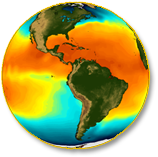The 2016 USGCRP Climate & Health Assessment
In April 2016, the United States Global Change Research Program (USGCRP) released a new assessment of a growing public health threat, The Impacts of Climate Change on Human Health in the United States: A Scientific Assessment. Drawing from decades of advances in the physical science of climate change, the report strengthens our understanding of the growing risks that a changing climate poses to human health and welfare, and highlights factors that make some individuals and communities more vulnerable than others.
The report emphasizes that "Climate change is a significant threat to the health of the American people. The impacts of human-induced climate change are increasing nationwide. Rising greenhouse gas concentrations result in increases in temperature, changes in precipitation, increases in the frequency and intensity of some extreme weather events, and rising sea levels. These climate change impacts endanger our health by affecting our food and water sources, the air we breathe, the weather we experience, and our interactions with the built and natural environments. As the climate continues to change, the risks to human health continue to grow."
The report presents 8 key findings by assessing recent analyses that quantify observed and projected health impacts for each finding. The report further identifies populations of concern, such as low income people, some communities of color, immigrant groups (including those with limited English proficiency), Indigenous peoples, children and pregnant women, older adults, vulnerable occupational groups, persons with disabilities, and persons with preexisting or chronic medical conditions. The vulnerability of any given group is a function of its sensitivity to climate change related health risks, its exposure to those risks, and its capacity for responding to or coping with climate variability and change.
Examples of Climate Impacts on Human Health are summarized in this diagram which shows specific examples of how climate change can affect human health, now and in the future.

In the spring 2017, the Medical Society Consortium released Medical Alert! Climate Change Is Harming Our Health which leverages the 2014 NCA and reinforces the 2016 USGCRP Health and Climate Assessment. Included in the report is a graphical depiction of U.S. with impacts plotted out by region. Of note: challenges to mental health and well-being are plotted across the entire United States.

Climate-related impacts on human health are not limited to the United States. The World Health Organization (WHO) states that climate change is the greatest threat to global health in the 21st century. The WHO promotes actions that both reduce climate change and improve health. The WHO sites air pollution as the greatest environmental risk to health of our time. Burning fossil fuels is the primary source of both climate-warming emissions and health-damaging air pollution. Reducing emissions of short-lived climate pollutants can generate immediate benefits for health and slow climate change. Actions to reduce both greenhouse gas emissions and short-lived climate pollutants are also measures to protect public health now and in the future.
Key air pollutants are (1) particulate matter, a mix of solid and liquid droplets arising mainly from fuel combustion and road traffic; (2) nitrogen dioxide from road traffic or indoor gas cookers; (3) sulphur dioxide from burning fossil fuels; and (4) ozone at ground level, caused by the reaction of sunlight with pollutants from vehicle emissions. The pollutant that affects people the most is particulate matter (often abbreviated as PM and used as a measure for air pollution).
